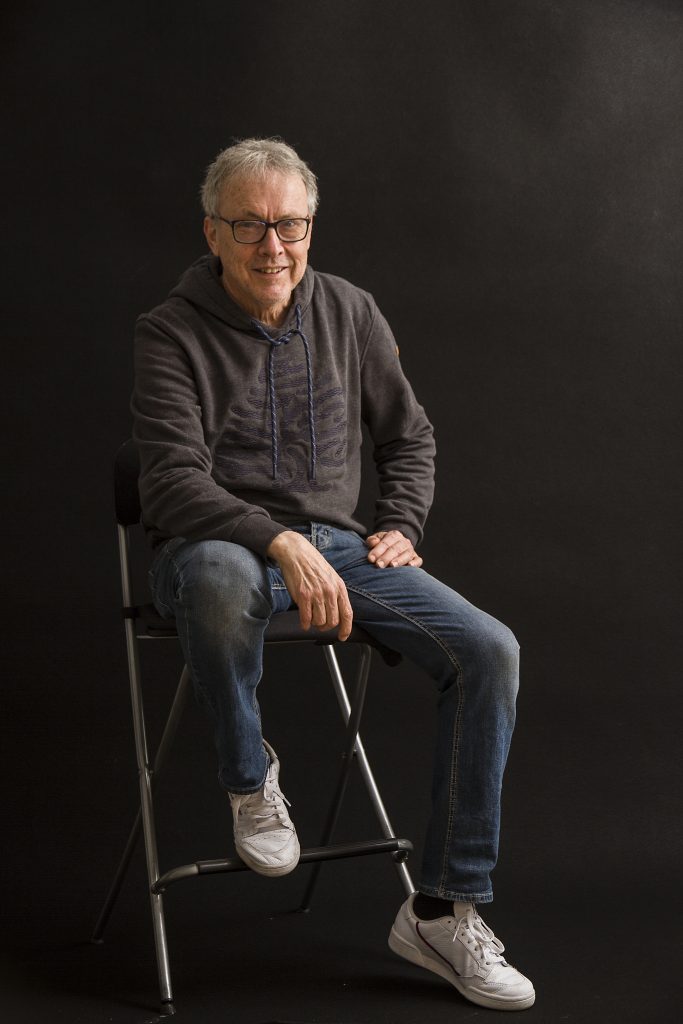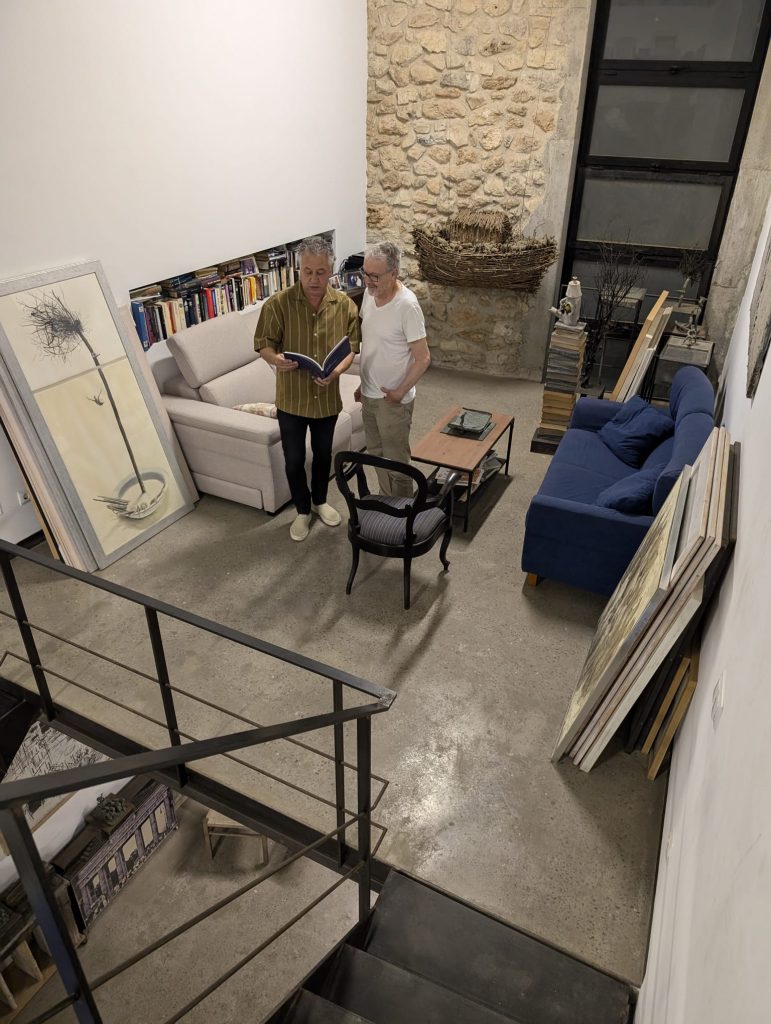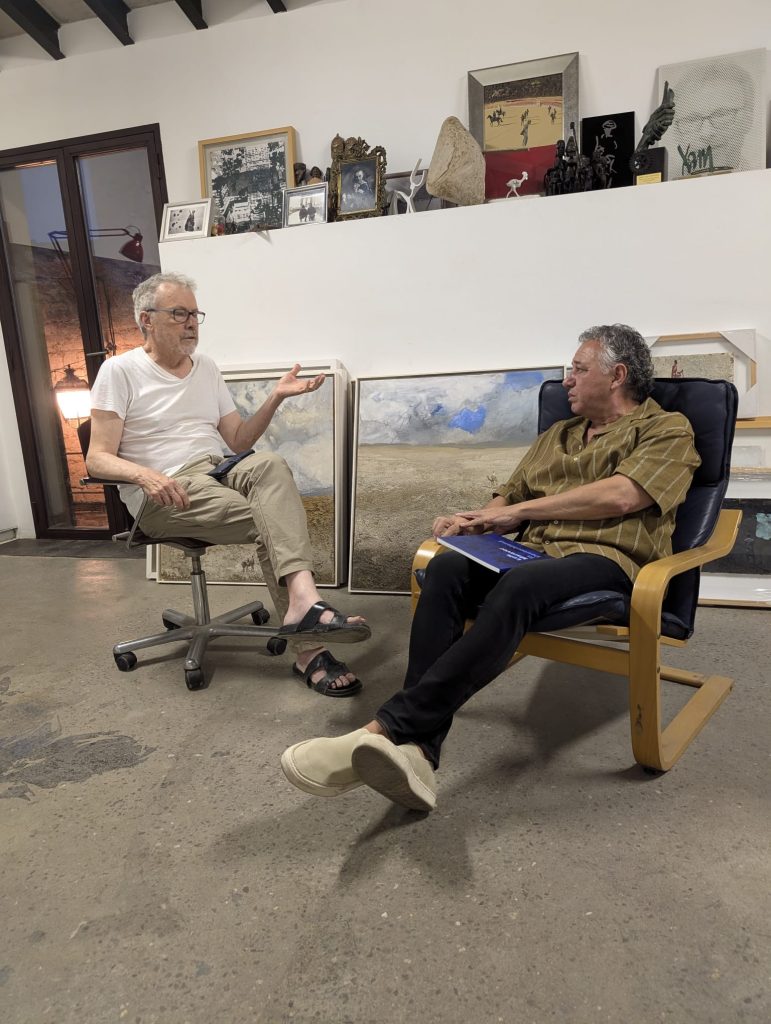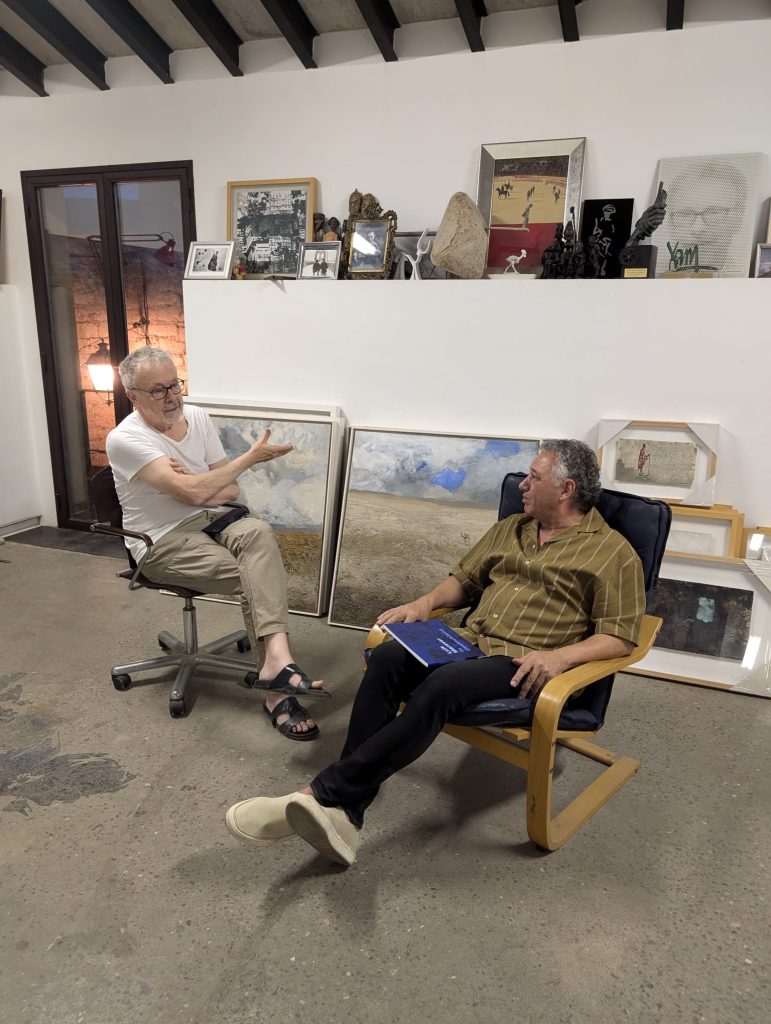
LUIS MARAVER
On the occasion of the THIRD anniversary of Kairoi Art Digital Museum, we would like to dedicate our recognition to an artist from Seville, who settled in the village of Binissalem more than thirty years ago; the painter and sculptor Luis Maraver.
Luis Maraver Moreno was born in Isla Mayor, a marshy plain by the Guadalquivir River, at Doñana National Park, on 27 October 1957.
As a child, he used to play on those dusty dirt roads, staring at the sky and watching the silver-coloured clouds that today float in his paintings.
His family moved temporarily to Puebla del Rio, and from there to Moron de la Frontera, where they lived for seven years. Coming from an isolated paradise, he struggled to get used to this busy new town, especially because there was an American base there.
At that time he already enjoyed drawing and painting.
He received a scholarship that allowed him to broaden his knowledge of plastic arts. He always praised his mother, who became a widow at a very young age and had to raise her four children on her own.
In 1972, a family member suggested that they should move to Majorca, where the whole family settled in easily and managed to find a house and a job.
During this time he met a man who transported paintings. It was by chance that he met Pascual de Cabo, who encouraged him to paint once he told him his story.
He always thanked Pascual for his encouragement, his teachings and his friendship, and for introducing him to those people who would later become important in Luis Maraver’s career, such as Joan Mesquida and Miquel Reus. And also the businessman Toni Ferrer, whom he met later on.
—
And so his first exhibition began…
It was held at the Galeria Moya, at Concepcion Street. The previous week had been somewhat eventful, because he had to finish painting some works of this collection, and at the same time he had to fill in for a friend who had had a work-related accident. That’s why he also worked as a beer delivery man in those days. However, this remained an anecdote, and nothing prevented the great success of his first exhibition.


The next one followed soon after, at the Circle of Fine Arts, and from then onwards to the present day. Exhibitions in different cities all over the world and also trips that have influenced his works, trips that were inspiring and enriching to him, as he says. He owns an extensive documentary archive, both visual and literary, in his travel notebooks, which began in 1981 on his first visit to Paris.
—
Years later, he was invited to take part in a great experience thanks to his friend Joan Mesquida, who had met with Puebla del Rio’s mayor and convinced him that Maraver was an exceptional artist. In those days, he met the man who was in charge of the town hall’s cultural management; ‘El Grande’, who became his closest friend from then on, and who he refers to as his travel guide.
Thirty days among the wetlands. The place where he was born and where he now has the opportunity to reconnect with his roots. Painting by day and well into the night, surrounded by mosquitoes, bugs, pine forests, and grasslands, within one of the greatest wildlife areas in Spain. An exciting job in Doñana, which he describes in his diary as; summer 1989…. A meeting with his past, located in a house in Dehesa de Abajo, working in solitude, where the past of lagoons and streams now met the new extensions of rice fields.
1990 was an impetuous year for his interests, as he worked with Galeria Bennassar to prepare a collection that he would present at Arco, with one of the works he created in Doñana. He recalls those days due to the broadcasting of his activity, featuring in the TVE news programme where he was interviewed as the best young artist at the Contemporary Art Fair (Arco), highlighting the fact that all his works had been sold. Thanks to this appearance, he made many contacts that boosted his career, and he met Manolo Escobar, an art lover who became a close friend of his, a friendship that would last until his death. That same year, 1990, he spent three months in New York working on a painting about ants, which he entitled ‘Más de 1000’ (More than 1,000), and which was acquired by a prestigious collector. He met Roy Lichtenstein, an important pop artist, cartoonist, sculptor and jazz musician who, coincidentally, was also born on October 27. He met personally with the gallery owner Leo Castelli, who could brag about owning the world’s foremost art gallery between Madison and 5th Avenues in New York. It was during this period that he met the American actress Lauren Bacall. New York welcomed him, making him feel as if he could touch the sky, but it was a very fast pace, hard to bear.
He made the wise decision to return to Majorca to strengthen his relationship with Pilar, the love of his life. Luis, Pilar, and their daughter Marina all settled in Binissalem, and later their sons, Luis and Alejandro, were born.
—
His exhibition list would be endless, as would his travels, anecdotes, adventures, friends, and admirers.
He has exhibited in countless places, in small and large formats, individually and collectively. New York, Frankfurt, Madrid, Paris, Cologne, Seville, London, Berlin, Valencia, Bologna, Granada, Zaragoza, Florence, Barcelona, Düren, Geneva, Santander, Ukraine, Valladolid, Moscow, Cadiz, Murcia, Munich, Athens, Cyprus, Pamplona, Menorca, Ibiza and Majorca are just some of these places.
In his travel notebooks, he always keeps a record of his travels, like delicate jewels made in sketches and watercolours. Kenya and Tanzania, Ukraine, Brazil, 1997/2000 Amazon, Peru, Rome, India, China, Morocco, Egypt, Berlin, Moscow and Jordan.
Morocco is one of the countries he has visited the most, attracted as he says he is by the atmosphere, markets, customs, people, and a rainbow of colours, which give him an energy that is hard to find anywhere else in the world, feeling as if time had stopped.
In 2023 he went to China with the artist Carlos Morell Orlandis, who allowed him to attend the University of Shanghai, where Morell works as a professor. There he prepared two master classes for students and teachers, based on his artistic technique. Curiously, it was on his birthday, so the students, and later on the professors, threw a party for him, grateful and impressed by Maraver’s explanations. He was invited to exhibit through HUELLART at the NINGBO Art Fair.
That same year, together with the NGO Llevant en Marxa, he travelled to Ethiopia and, coming from such an advanced place as Shanghai, he was struck by the contrast. For eleven days, he joined a group of doctors and nurses to visit the Mursi people, indigenous tribes who are unaware of technology and live in a rudimentary way as their ancestors did, with their rituals and traditions. These experiences bring Maraver closer to the land, the roots, to remote philosophies of life that he then captures with emotion on canvases and formats of all sizes, using textures, pigments, latex, pencils, varnishes, marble dust, metals, sands, straw, ashes, accelerators and other materials.
Maraver keeps astonishing himself with atavistic scenes, where he can glimpse the heartbeat of a human being who dwells far from technological futures.

The book written by Pere Joan Martorell is a recommended reading; ‘El viatge infinit’ (The endless journey); pictures, observations and comments where, as an extraordinary and extensive document, he gathers essential parts of his wanderings.
Travelling has enriched him as a person and as an artist, sharpening his eye to absorb the range of tones that nature gives to each landscape, city and village. He has been trained by experience, learning to observe, to discuss, and to study customs and rituals from centuries ago. Even though artists do not usually define themselves, he briefly analysed himself by describing two of his passions, art and travelling: ‘I am a seeker of cultures, images and experiences. Travelling is learning, it is knowledge. My work involves an exploratory game based on colour, the density of matter and space’.
Among his hobbies, he declares that he enjoys cinema, reading, watching sporting events and spending time with friends.
In his paintings and sculptures, he has granted heart, fibre, muscles, organs, cells and the identity that allows any detail to be related to his wisdom, building scenarios in which iconography, mysticism and symbology go along ashen clouds, leaden skies, mysterious pyramids, arid deserts, Indian faces, children running along the banks of the Amazon, or those elements and characters that he deliberately embeds in the main body of matter; Wally, Bart Simpson, Spiderman. His painting has never lost its freshness. It has been postulated as a conceptual technique that identifies itself and in which impressionist, expressionist, neo-expressionist, abstract, futurist, physical and chemical verses can be read.
A slight memory that takes us back to his beginnings allows us to know that he was interested in the impressionist painting of Joaquin Mir, for the freedom and intuition that he applied to his work, later in Claude Monet, and the matter painting of the neo-expressionist artist Anselm Kiefer, which he considers himself a faithful admirer of. In his memories, he recalls the impact of the first Tapies exhibition he visited, and his close friendship with the Felanitx sculptor Jaume Mir, who taught him to appreciate sculpture.
Luis confesses being a loyal man to those who have trusted him, as is the case of his special relationship with Galeria Bennassar, who allowed him to exhibit at Arco.
He says that after more than forty years devoted to painting, he paints whatever he wants with the same feeling he had when he set his brushes in front of a blank canvas for the first time.
Thank you for joining the Kairoi Art Digital Museum family as we celebrate our third anniversary.
For more information… www.kairoi-art.es
Text: Xisco Barceló
Pictures: María Valiente